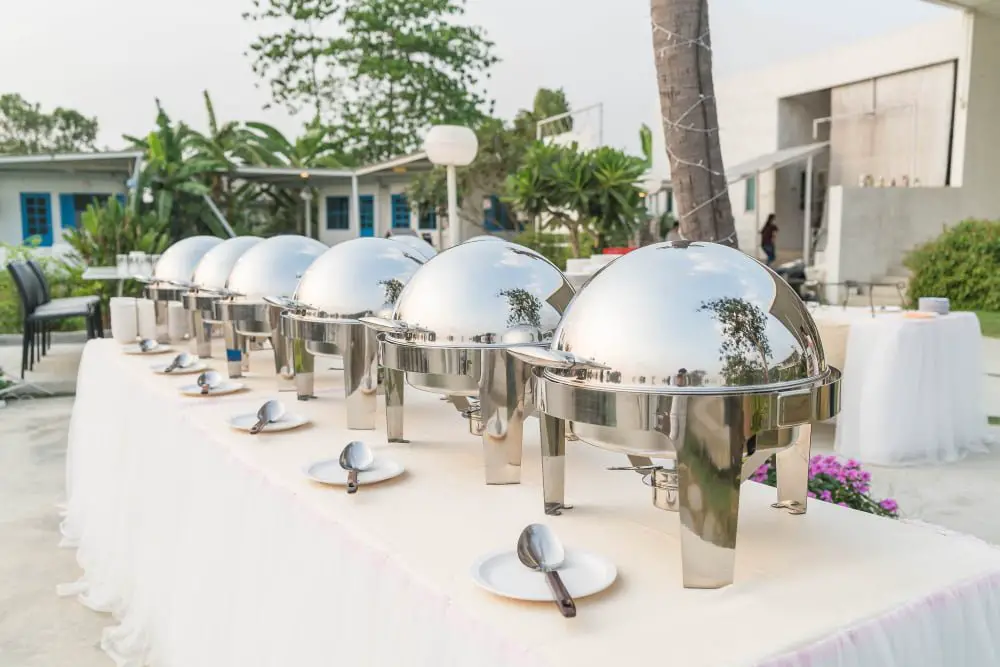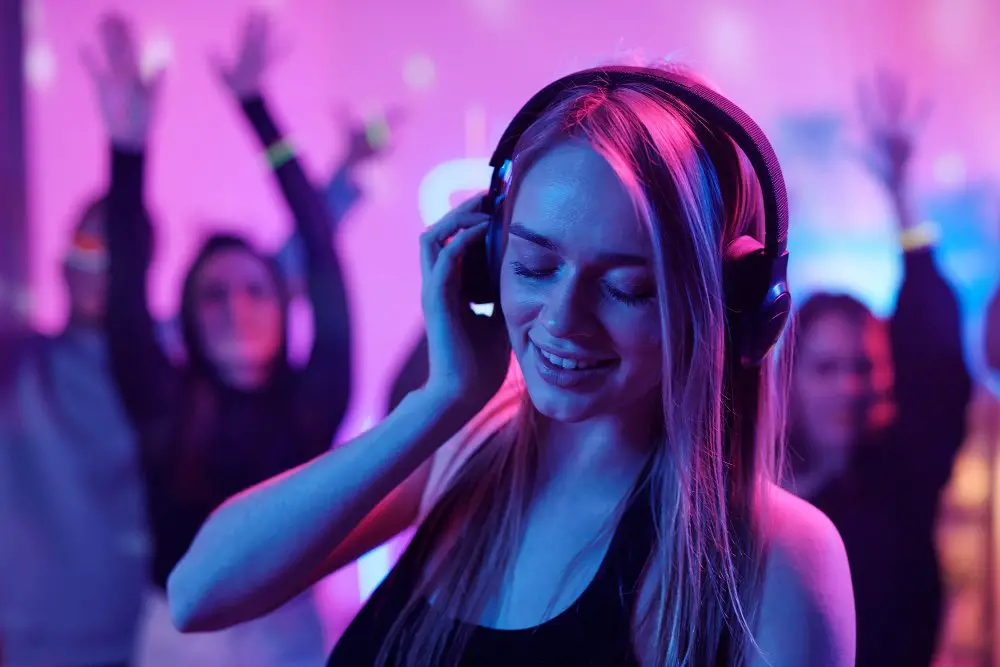Uncover the essential elements to consider when setting up a dance floor for an unforgettable outdoor wedding celebration.
Creating an enchanting dance floor for an outdoor wedding can transform your reception into a magical celebration. With the right materials, placement, and decor, you can ensure your guests will be dancing the night away under the stars.
This article will guide you through the process of selecting the right type of dance floor, how to position it for the best ambiance, and how to adorn it to match your wedding theme. Whether you’re envisioning a rustic barn dance or a sophisticated soiree, you’ll find all the details you need right here to bring your outdoor wedding dance floor dreams to life.
Choosing the Right Location for Your Dance Floor
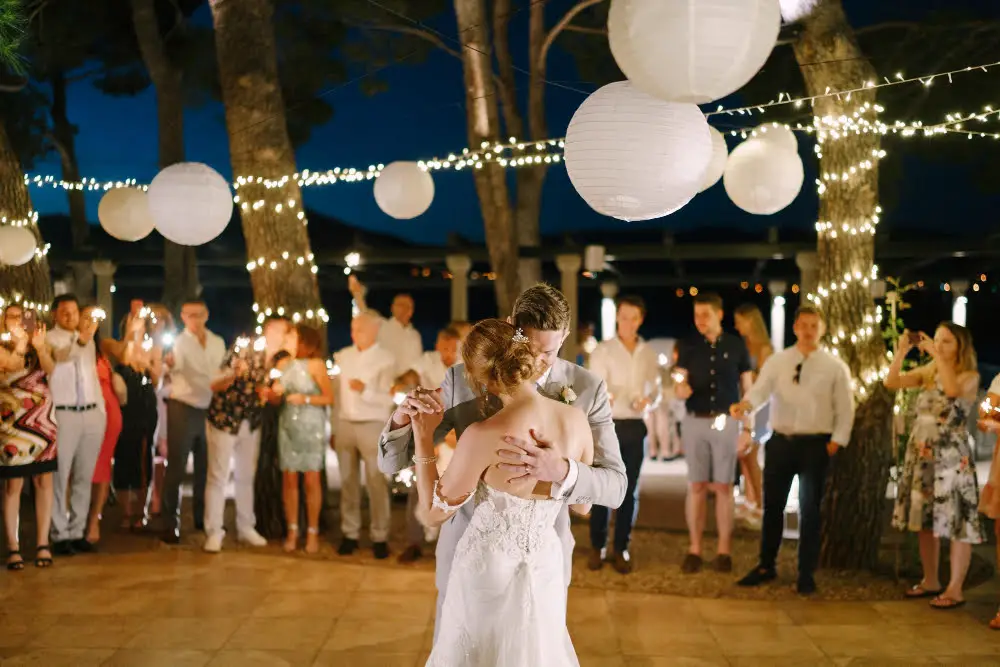
Identifying a suitable spot hinges on several factors. First, consider your wedding’s layout, aiming for a location central to the action yet distant enough to avoid disrupting non-dancing guests. Second, the terrain plays a critical role. As fun as the twist and twirl beneath the open sky may be, doing so on an uneven surface can turn risky. Thus, ensure your chosen area is flat and firm to prevent dance-related accidents.
Also, consider the proximity to power sources if you plan to have a live band or DJ. Finally, always have a backup location in case of unfavorable weather conditions. With these in mind, your guests will be boogieing blissfully in no time.
Types of Outdoor Dance Floors
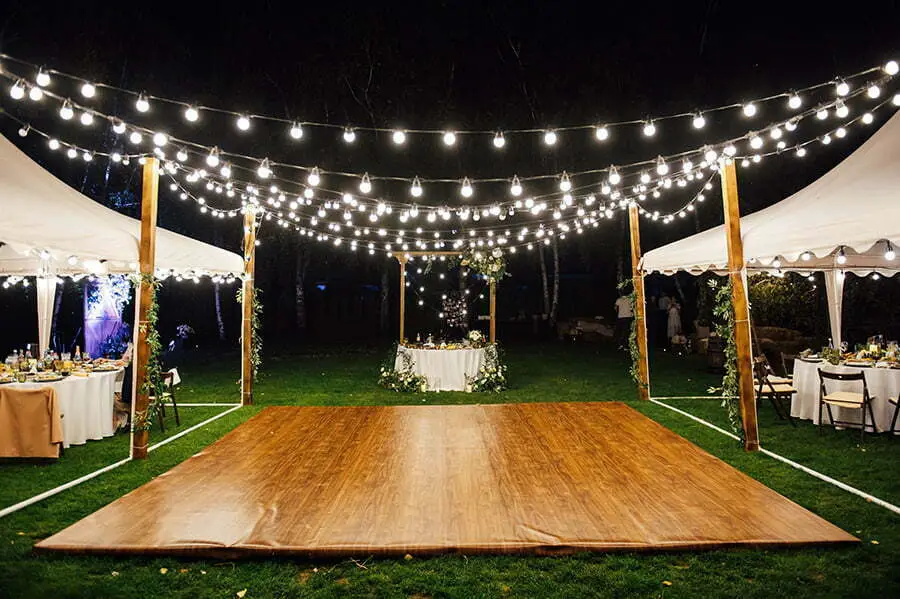
It’s crucial to understand the different types that are available in order to make an informed choice. Temporary dance floors, typically constructed with interlocking panels, are a popular choice for their ease of assembly and versatility.
They can easily adapt to different ground surfaces like grass or gravel. Something to consider, though, is your wedding theme. For a rustic or bohemian ambiance, rustic wooden planks could add the perfect touch. Alternatively, a checkered black and white floor might be the perfect fit for a more vintage or classic style.
If you’re leaning towards sophistication, consider a glossy parquet floor or one illuminated with LEDs. Meanwhile, a plexiglass dance floor installed over a pool adds a dreamy, surreal vibe. Each style comes with its own aesthetic appeal and practical considerations, defining the overall look and feel of your celebration.
Popular Material Choices for Outdoor Dance Floors
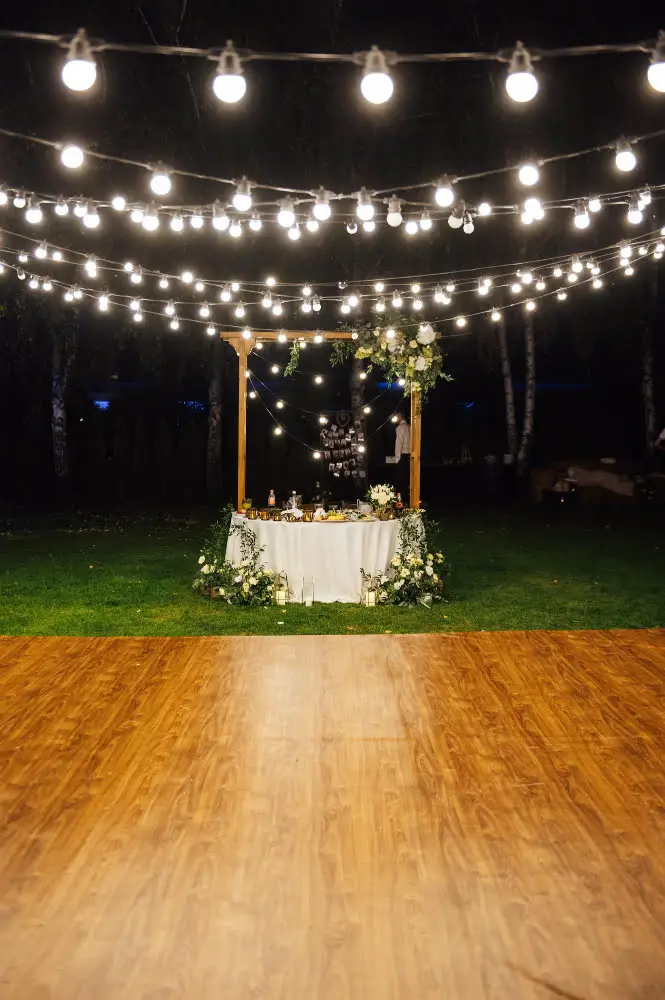
When it comes to material selection, there are a few tried-and-true options that balance aesthetics, durability, and dancer comfort.
Wood, perhaps the most traditional choice, offers a classic look and warm, inviting feel.
Opt for purpose-built panels, which are designed to interlock seamlessly, providing a safe, sturdy, and gap-free surface that’s perfect for dancing.
Alternatively, consider vinyl dance floors.
These provide a smooth, easy-to-clean surface, are relatively lightweight, making them easy to install and remove, and can be ordered in a variety of colors and patterns.
However, they can get a bit slippery, especially in damp weather, so keep this in mind.
Finally, acrylic dance floors are a sleek, modern choice perfect for couples who love a contemporary aesthetic.
These floors come in clear or colored panels, allowing for creative lighting options and a sense of added space.
Despite their sophisticated look, they can be a bit harder on feet and less forgiving for falls.
Therefore, if you have many elderly guests or those with mobility issues, this may not be the best choice.
Size Considerations for Your Wedding Dance Floor
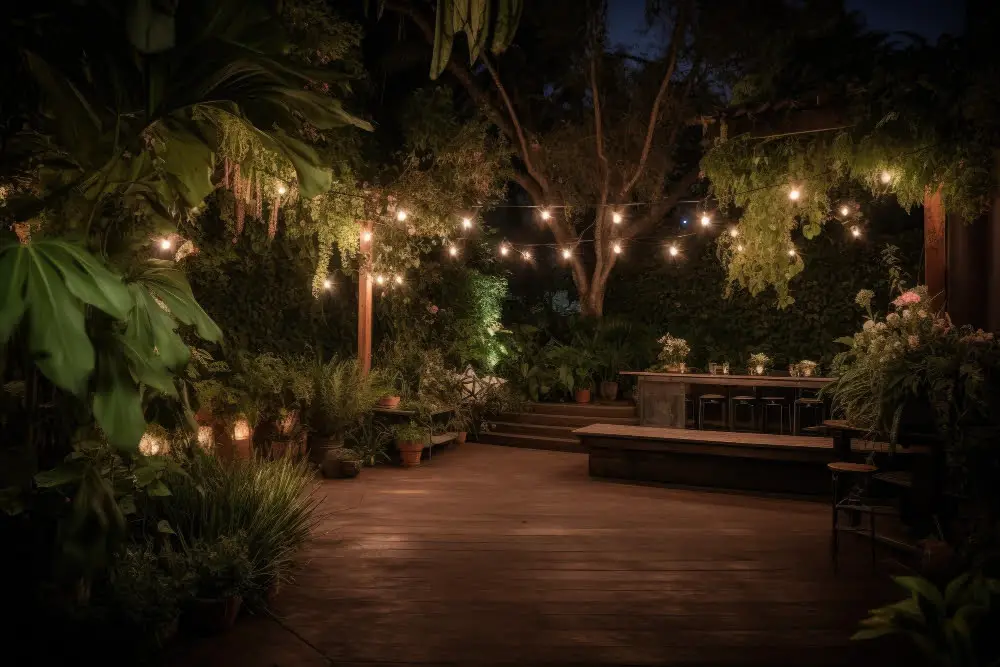
To determine the ideal dimensions for your dance floor, consider the number of guests you’re expecting.
Experts recommend allotting 9 square feet per couple.
Thus, a wedding with 100 guests dancing in pairs would need a dance floor around 450 square feet.
This area allows everyone ample room to dance comfortably, without fear of bumping into each other.
Remember to account for any additional features like a DJ booth or live band, which may require more space.
Careful planning ensures a smooth, uncluttered dancing experience and keeps your guests happy and engaged.
How to Mark Out a Space for Dancing
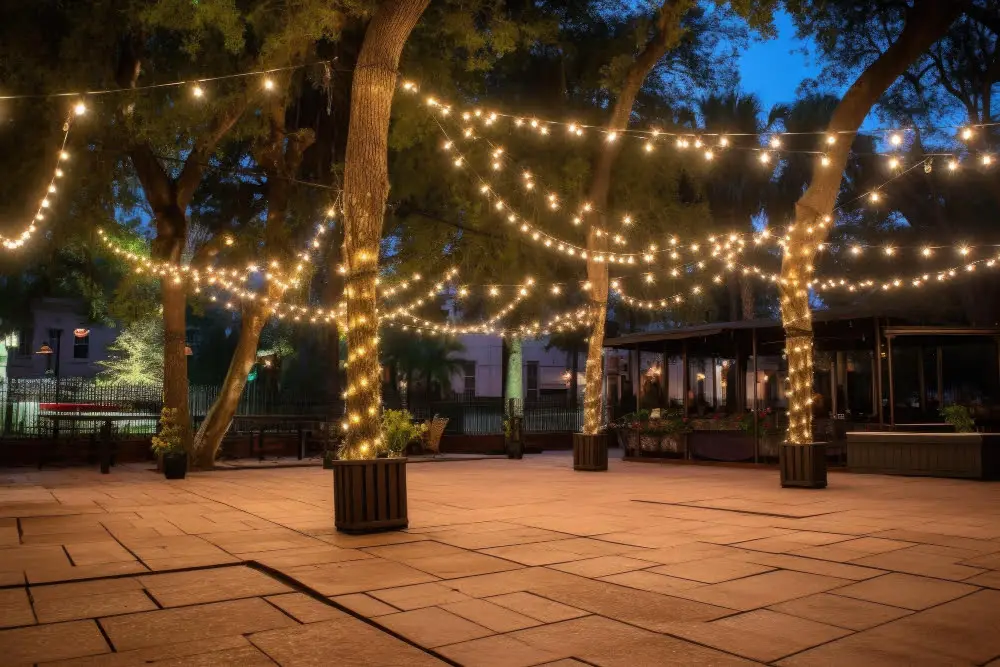
Start by determining the number of guests. As a rule of thumb, allocate four to five square feet per dancer.
If you expect all guests to dance simultaneously, you will multiply the total number of guests by this figure.
To mark the dance floor area, use biodegradable marking paint or large potted plants for an eco-friendlier approach.
Consider rectangular or square shapes to maximize space.
Don’t disregard the need to leave enough room for foot traffic around the area.
Most importantly, ensure it is centrally located, visible, and accessible to all.
Think about placing it near the best scenery to capitalize on your outdoor setting.
Keep in mind that the band or DJ should be situated close to the dance area for a more enhanced atmosphere.
Footwear Considerations for Outdoor Dancing
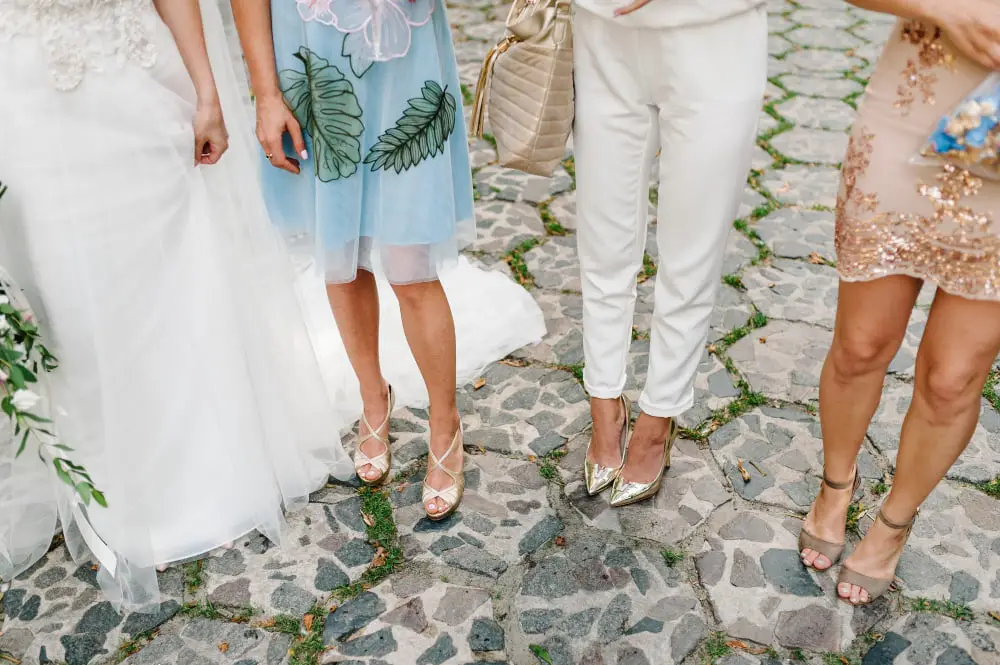
While planning the design and layout of your outdoor dance floor, it’s essential to consider the type of footwear your guests might be wearing.
For instance, high-heeled shoes may not be the best choice for a dance floor laid on soft grass or a sandy beach.
To keep your guests comfortable and their dancing unhindered, opt for a solid surface like wood or vinyl.
Additionally, a friendly reminder in your wedding invitation about appropriate footwear for the outdoor reception could be beneficial.
Going one step further, you might want to provide fun and comfortable flip flops for the ladies, ensuring everyone can fully participate without risking an ankle!
Decorating an Outdoor Dance Floor

Adding personal touches and thematic elements to your dance floor can visibly enhance its overall appeal. Incorporating wedding colors through drapes, ribbons or painted designs subtly emphasizes the wedding theme.
Flowers and greenery may be intertwined around railings or posts, if available. An arch or two of balloons, fabric, or foliage tastefully arching the entrance to the dance floor instantly elevates the visual intrigue.
Unique rug placements around the borders, vintage lanterns or fairy lights tied around the edge, and customized dance floor decals can also create a distinctive vibe matching the personality of the couple. Always remember, balance is key in achieving an alluring yet uncluttered look.
Incorporating these decor strategies can create a dance floor that’s not just functional, but also a glamorous focal point of your outdoor wedding reception.
Lighting Options for Your Dance Floor

From fairy lights strung overhead to LED dance floors, your lighting choices can create an alluring atmosphere.
While twinkle lights are perfect for a whimsical woodland wedding, tinted uplighting can bring a dramatic touch to an elegant event.
If your wedding runs into the night, consider lanterns around the perimeter for a soft, romantic glow.
Keep in mind that all lights should be safely and professionally installed to prevent potential hazards.
You can involve a professional lighting designer to ensure the illumination perfectly complements your wedding theme and ambience while guaranteeing the safety of your guests.
Featuring Your Monogram On the Dance Floor
There’s something uniquely special about seeing your initials taking center stage on your outdoor dance floor. Whether illuminated by glistening fairy lights or elegantly placed using vinyl adhesives, the monogram can become a focal point that truly personalizes your wedding and impresses your guests.
Remember this display should be designed to withstand foot traffic while still providing a smooth surface for dancing. Consider using durable materials and ensure your monogram doesn’t present any slipping hazards. Also, choose a design that aligns with your overall wedding theme.
You can consult with your wedding planner or a professional designer to come up with the best way to place your monogram on the dance floor, taking both aesthetics and practicalities into account.
Inspiration for Outdoor Wedding Dance Floors
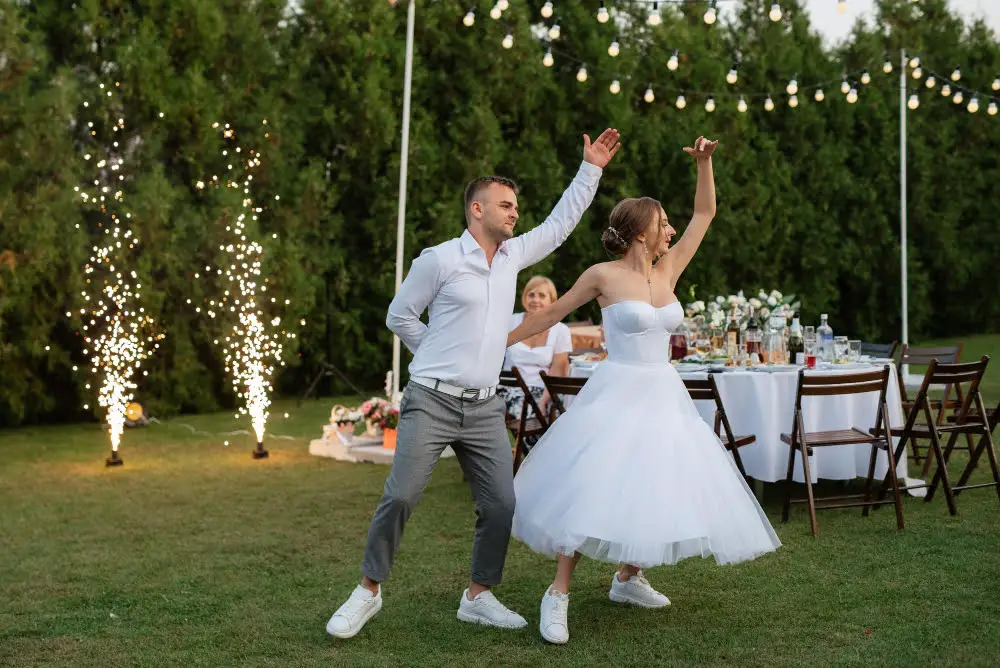
Canvassing trends and ideas from various sources can spark your creativity. Social media platforms like Pinterest and Instagram are teeming with photos and ideas that can influence your choice of dance floor. From simplistic hardwood floors surrounded by fairy lights to extravagant vinyl floors with personalized monograms, your options are limitless.
Additionally, wedding magazines, websites, and decorators can offer insight into the latest and most popular ideas. Ultimately, the best dance floor will flawlessly mirror your theme and personality. Whether you choose a bohemian chic look, with rugs and lanterns, or a sublime classic style with chandeliers and white florals, ensuring it resonates with the rest of your wedding decor is key.
DIY Outdoor Wedding Dance Floor Ideas
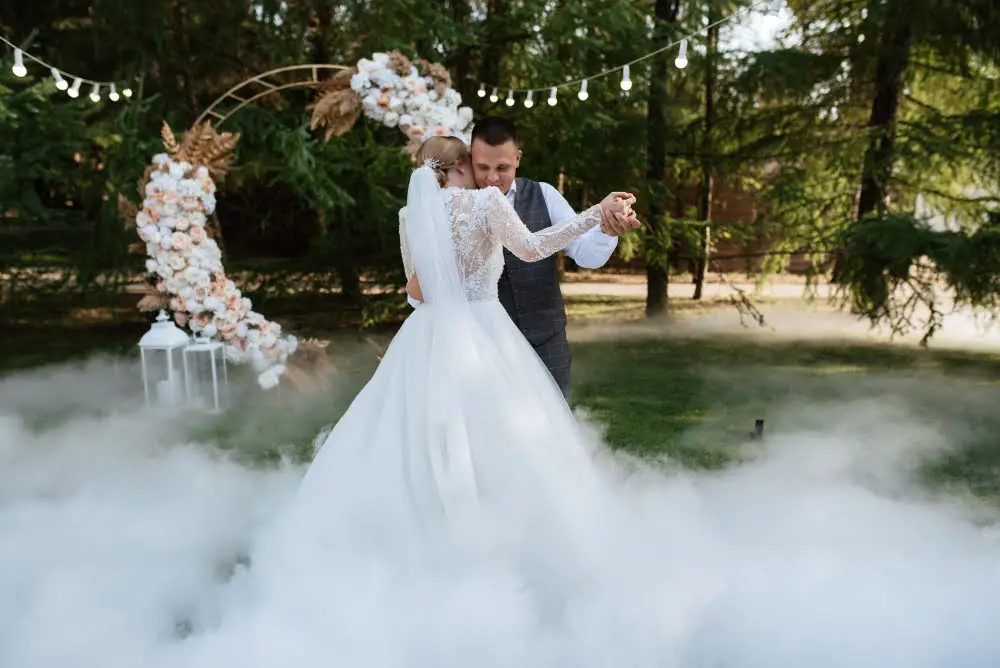
There’s a certain allure to undertaking the project yourselves as bride and groom. Not only does this offer potential cost savings, but it also injects a personal touch into the celebration.
Utilizing simple tools and materials like pallets, plywood, or vinyl, you can create an impressive DIY dance floor.
Keep in mind that assembly and disassembly time should be factored into your wedding day schedule.
Regardless of the design, ensure a solid and level foundation—a smooth and sturdy surface is paramount for the safety of your dancing guests.
And lastly, never underestimate the transformative power of accessories such as outdoor rugs, fairy lights or potted plants to add a touch of personality and charm to your DIY creation.
Renting Vs. Buying an Outdoor Dance Floor
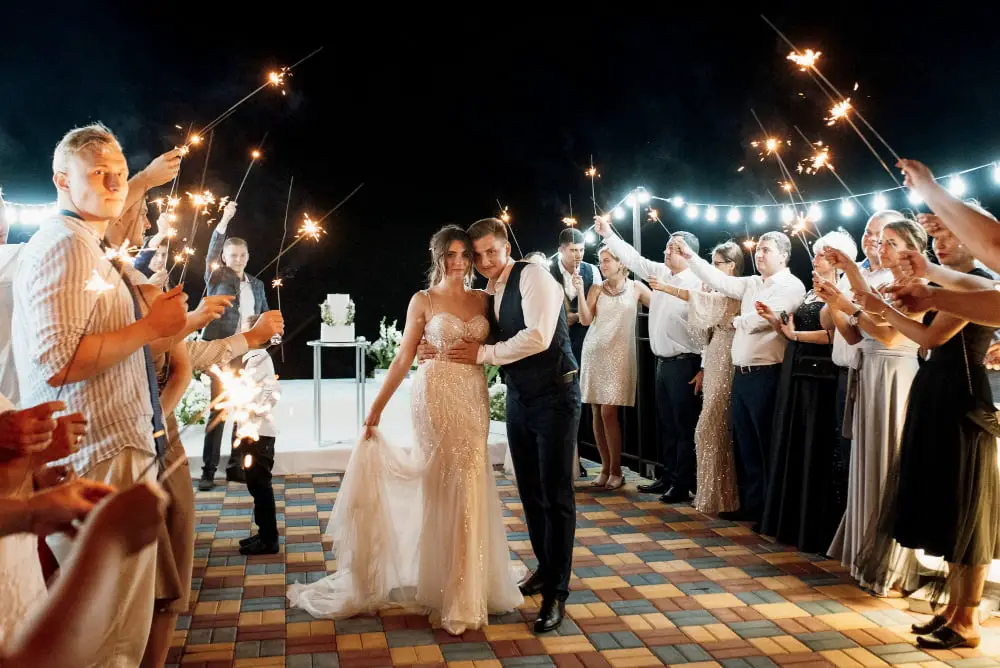
Weighing whether to rent or buy can seem perplexing but understanding the nuances of both options can help you make an informed decision.
Generally, rentals can offer the flexibility and variety you need without demanding a hefty investment. They typically come complete with delivery, setup, and teardown services, ensuring a hassle-free experience.
On the other hand, purchasing can provide a tailored touch particularly for remote or hard-to-access locations where rentals may be a challenge. With this option, you also have the chance to resell the dance floor after your event, possibly recouping part of your investment.
However, consider the added responsibility for installation and removal that comes with ownership.
In the end, weigh the cost, convenience, variety, and disposal factors of each option against your unique situation to decide what fits best with your overall wedding plans.
Installation Process for Outdoor Dance Floors
To begin the installation, ensure the selected area is even, free of debris, and near enough to your reception to entice your guests to dance.
Once the site is prepped, start laying down the dance floor panels. These custom-made sections typically interlock, creating a smooth surface for your guests to dance on. The floor should be secured to keep it stable and to prevent accidents.
Hiring a professional team to install the dance floor is recommended, ensuring it’s safe and ready for dancing on your big day. Additionally, their expertise can be invaluable in positioning and securing the floor in less-than-ideal conditions.
Utilizing Existing Space for Dance Floor
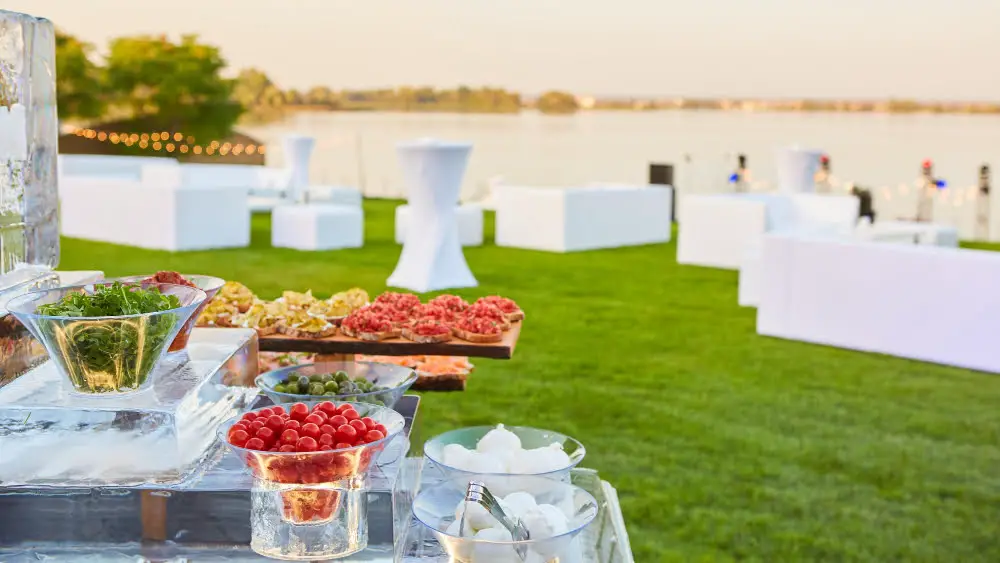
Working with your venue’s natural layout is an effective way to ensure seamlessness while adding charm to your reception.
A flat, grassy area or even a patio can serve as a fantastic dance floor space with little to no modification.
Well-trimmed lawns, particularly, offer soft and even ballroom-like surfaces.
Patios or decks, on the other hand, near the dining area can form perfect dance spots, encouraging everyone to join in and have fun.
Remember, the key is to assess the ground for any potential hazards like uneven terrain or rogue pebbles to ensure guests’ comfort and avoid trip-ups.
Incorporating the existing space more naturally allows you to keep the genuine vibe of an outdoor wedding and can save on the cost and effort of installing a separate dance floor.
Preventing Dance Floor Slip-ups and Accidents

Having a safe environment to dance is essential for the enjoyment of your guests. Start by ensuring the dance floor is leveled, to avoid uneven surfaces that can cause trips or sprains.
If you’re dealing with grass or uneven outdoor terrain, consider professional installation and high-quality flooring designed to smooth out inconsistencies.
To manage potential spills and wet weather, absorbent, non-slip mats around the bar and perimeter can serve as a safe buffer zone.
Request your band or DJ to remind guests about the proper dance floor etiquette, especially avoiding glassware on the dance floor.
Regular checks and prompt maintenance during the event can equally keep the dancing uninterrupted and accident-free.
Safety Tips for an Outdoor Dance Floor

Implementing safety measures is crucial to ensure a carefree celebration. Start by taking care of sharp edges and corners; padding or some form of protection can minimize potential injuries.
Lighting is another critical aspect. Illuminate the area well to avoid any accidental trips or falls, but avoid harsh, bright lights that may create a stark atmosphere.
Additionally, always have a plan for sudden weather changes. Consider slip-resistant floor materials and keep handy resources like absorbent quick-dry towels to handle unexpected rain or spills.
For added peace of mind, make sure your floor supplier has liability insurance covering any dance-floor related incidents.
Weather Considerations for an Outdoor Dance Floor
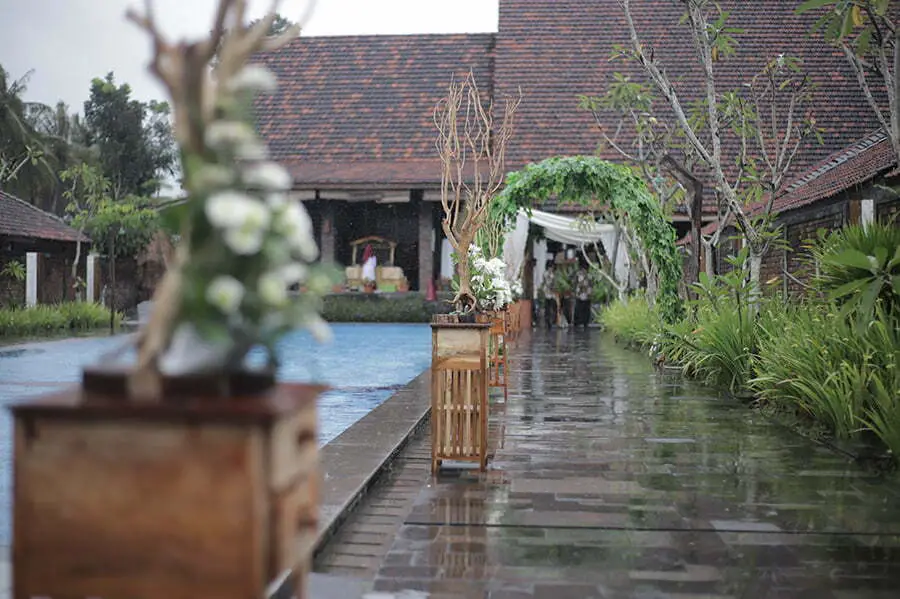
While planning an outdoor wedding, it’s crucial to prepare for unpredictable weather conditions.
A sudden downpour can turn a stunning dance area into a slippery danger zone.
Opt for weather-resistant materials like vinyl or acrylic, which can withstand moisture and won’t become unsafe when wet.
In case of sunny weather, consider a canopy or outdoor tent for shade which can protect the guests from the sun’s heat.
It is also worth having a backup indoor location, especially in areas prone to abrupt changes in weather conditions.
Always keep an eye on the forecast and make adaptations as necessary to ensure the safety and comfort of your guests.
How to Protect Your Outdoor Dance Floor

To ensure the longevity of your dance floor, employ several protective measures.
Consider a high-quality floor cover, such as a tarp or specialist weather-resistant floor covering, to shield from elements like rain or strong winds.
Installing a canopy or marquee over the dance area can also provide ample protection while contributing to your decor.
Also, regular maintenance tasks, such as sweeping to remove dirt and leaves, can help prevent damage.
Lastly, ensuring all drinks are kept off the dance area minimizes the risk of spills that could slip up dancers or damage the flooring.
Accessibility Considerations for an Outdoor Dance Floor

Considering all of your guests when planning your outdoor wedding dance floor is a thoughtful detail that won’t go unnoticed.
Ensure ramps or graded paths are available for wheelchair access.
Make sure the surface is even, with minimal bumps or dips that could cause difficulties for guests with mobility issues.
Take lighting into account too – a well-lit dance floor can prevent accidental tripping, aiding guests with visual impairments.
By planning for access, you create an inclusive environment where everyone can celebrate together, dancing the night away.
FAQ
How to make a dance floor for outdoor wedding?
To create a dance floor for an outdoor wedding, consider laying down a substantial, robust rug such as jute or bamboo, and secure its edges using tent pegs for stability.
What is the alternative to a dance floor at a wedding?
An alternative to a dance floor at a wedding could be the creation of relaxing firepit and lounge areas, featuring elements like tables with umbrellas, benches, couches, throw rugs, or simple wooden stumps for a spread-out, laid-back ambiance.
Can you put dance floor on grass?
Yes, for outdoor wedding receptions, a dance floor can be successfully laid over the grass to create a safer and more comfortable environment for guests.
Do you need a dance floor on grass?
Yes, a dance floor is recommended for an outdoor wedding on grass to ensure guest comfort and to avoid the issues posed by potentially muddy or uneven ground.
What are the best materials for constructing an outdoor wedding dance floor?
Hardwood, acrylic, and plywood are excellent materials for constructing an outdoor wedding dance floor due to their durability, ease of installation, and aesthetic appeal.
How can one ensure the safety of guests on a grass dance floor?
Ensure the safety of guests on a grass dance floor by rigorously checking for any hazards such as holes or sharp objects, and by covering the area with an even, slip-resistant dance floor surface designed for outdoor use.
What factors to consider while selecting a location for the dance floor in an outdoor wedding?
When selecting a location for the dance floor at an outdoor wedding, consider factors such as terrain evenness, covered area for unexpected weather changes, proximity to power sources for audio equipment, space sufficient for attendees, and its placement for best flow of activity and visual appeal.
Keep reading:


